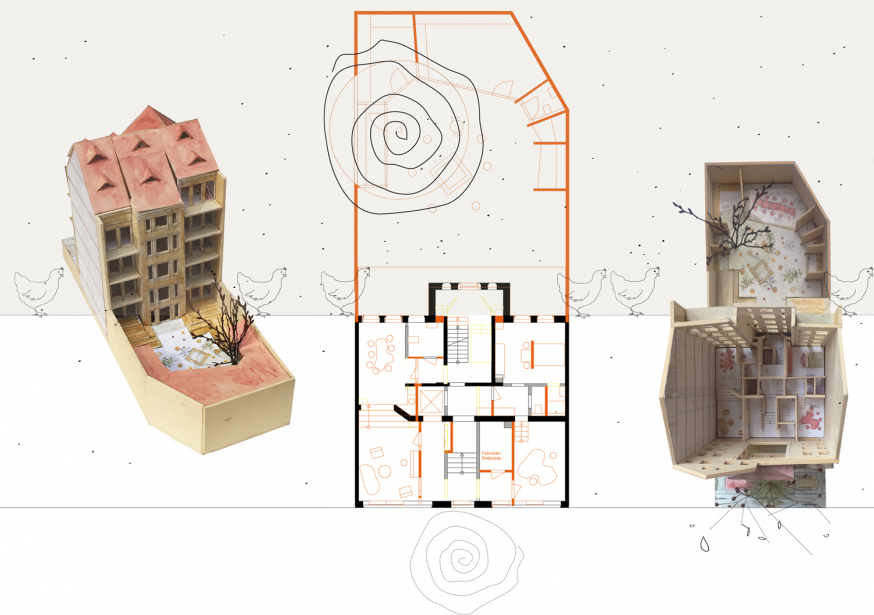The Leipzig Model
Background
The project “Over 60 – Design for Tomorrow” was organised in the context of the Grassimesse 2012 in Leipzig. Students from three design universities in Halle, Schneeberg and Bozen were tasked with developing products for older people. The results were very successful. After Leipzig, the project was presented at furniture trade fairs in Cologne, Munich and Milan. The exhibitions at all events attracted great interest. From this experience, the following question arose: Would it be possible, as a pilot project, to design not just products but an entire house for older people?
Demographic changes are presenting us with new challenges. How do we want to live when we get older? What possibilities are offered by the current models of living and caregiving? How can we ensure that older people can continue to interact with society and their neighbourhoods? Older people spend 80% of their time at home.
Aim
The aim of the “Leipzig Model” is to launch an innovative model project in Leipzig that explores possibilities for sustainable, future-oriented living against the backdrop of demographic change. The project should demonstrate that a well-thought-out typology, sophisticated architecture and attractive design can make a significant contribution to enabling independent living well into old age. In addition, it should serve as a beacon in Leipzig and help create an open, innovative image for the city. The basic concepts of “design for all” should be applied as fundamental principles. The design should not only help ensure that residents can live independently as long as possible, but also support contact and interaction with the surroundings, preventing isolation.
The “Leipzig Model” will be implemented in a typical Gründerzeit building in Leipzig. The project will focus on a timeless, well-thought-out architectural concept with attractive, high-quality furnishings and design. The support of social interaction is based on not only a mixing of the residential typologies, but also targeted interventions in the collectively used areas of the house, garden and immediate surroundings. The use of high-tech and assistance systems should be minimised. In terms of its structure, the “Leipzig Model” can be categorised as a multigenerational house. The house is being planned for six to ten flats. Around 70% of the flats will be reserved for elderly residents, and the remaining flats will be developed for families or students and designed to meet their needs. The planned facilitation of communication among the residents is considered an important contribution to the creation of a social network.
The project is based on the following principles
1. Independent living, yes; loneliness, no! Great care will be taken to integrate spatial situations for planned or unplanned encounters, like benches in front of the entrance, sitting areas on the landings and a workshop for communal arts and crafts activities.
2. Every person is unique, even in old age! The flats will have different sizes and will be designed to ensure that the interior layout can be adapted – at least to some extent – to the needs and preferences of the resident. The furnishings can be a mixture of new, adapted and self-owned furniture.
3. More extras. An exhibition space will be integrated into the house as a site for brainstorming and a point of contact. These rooms, which can also serve as a flat for guests, will be continually redesigned to accommodate current developments, ideas and products. It will be a place where current products and projects can be displayed, tried out and experienced. In this area, informational materials will be made available, advice will be shared and events will be held. It will be a place with many different sources of inspiration for anyone interested. And a place where the latest research findings can be made transparent for the public.
- Oh and let’s not forget nature! Interaction with the surrounding urban space should be supported. Spending time outdoors is very important in old age. In the garden, small allotments and a vegetable garden where residents can grow their own food will provide outdoor spaces for spontaneous encounters and enjoying the fresh air.
Press
Gemeinsam alt sein
Alten WG Mehrgenerationenhäuser sind konkrete Utopie der alternden Gesellschaft. Wie man solche Konzepte verwirklichen kann, zeigt das „Leipziger Modell. Zwei Architektinnen, die das Projekt initiieren, setzen sich dabei auch mit dem Thema Armut auseinander.
Author: Heide Reinhäckel
taz 9/10 Mai 2015








